windshield Acura TL 2000 3.2 User Guide
[x] Cancel search | Manufacturer: ACURA, Model Year: 2000, Model line: TL, Model: Acura TL 2000Pages: 311, PDF Size: 3.05 MB
Page 190 of 311
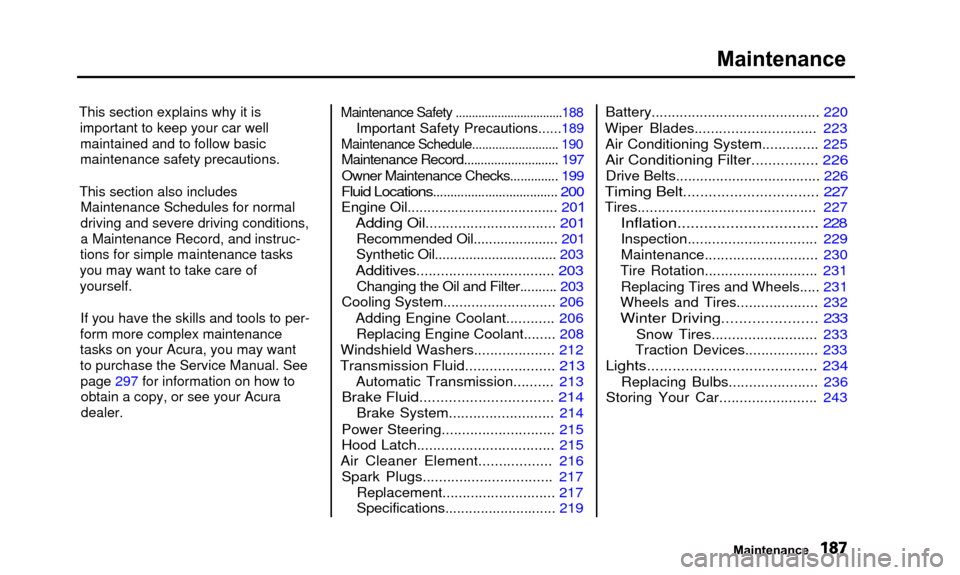
Maintenance
This section explains why it isimportant to keep your car wellmaintained and to follow basic
maintenance safety precautions.
This section also includes Maintenance Schedules for normal
driving and severe driving conditions,
a Maintenance Record, and instruc-
tions for simple maintenance tasks
you may want to take care of
yourself.
If you have the skills and tools to per-
form more complex maintenance
tasks on your Acura, you may want
to purchase the Service Manual. See page 297 for information on how toobtain a copy, or see your Acuradealer. Maintenance Safety .................................188
Important Safety Precautions......189
Maintenance Schedule
.......................... 190
Maintenance Record ............................ 197
Owner Maintenance Checks.............. 199
Fluid Locations.................................... 200
Engine Oil...................................... 201
Adding Oil................................ 201
Recommended Oil...................... 201
Synthetic Oil................................ 203
Additives.................................. 203
Changing the Oil and Filter.......... 203
Cooling System ............................ 206
Adding Engine Coolant............ 206 Replacing Engine Coolant........ 208
Windshield Washers .................... 212
Transmission Fluid...................... 213
Automatic Transmission.......... 213
Brake Fluid................................ 214
Brake System .......................... 214
Power Steering ............................ 215
Hood Latch.................................. 215
Air Cleaner Element .................. 216
Spark Plugs................................ 217
Replacement............................ 217
Specifications............................ 219Battery..........................................
220
Wiper Blades.............................. 223 Air Conditioning System.............. 225
Air Conditioning Filter................ 226
Drive Belts.................................... 226
Timing Belt................................ 227
Tires............................................ 227
Inflation................................ 228
Inspection................................ 229
Maintenance............................ 230
Tire Rotation............................ 231
Replacing Tires and Wheels..... 231
Wheels and Tires.................... 232
Winter Driving...................... 233
Snow Tires.......................... 233
Traction Devices.................. 233
Lights........................................ 234
Replacing Bulbs...................... 236
Storing Your Car........................ 243
Maintenance
Page 202 of 311
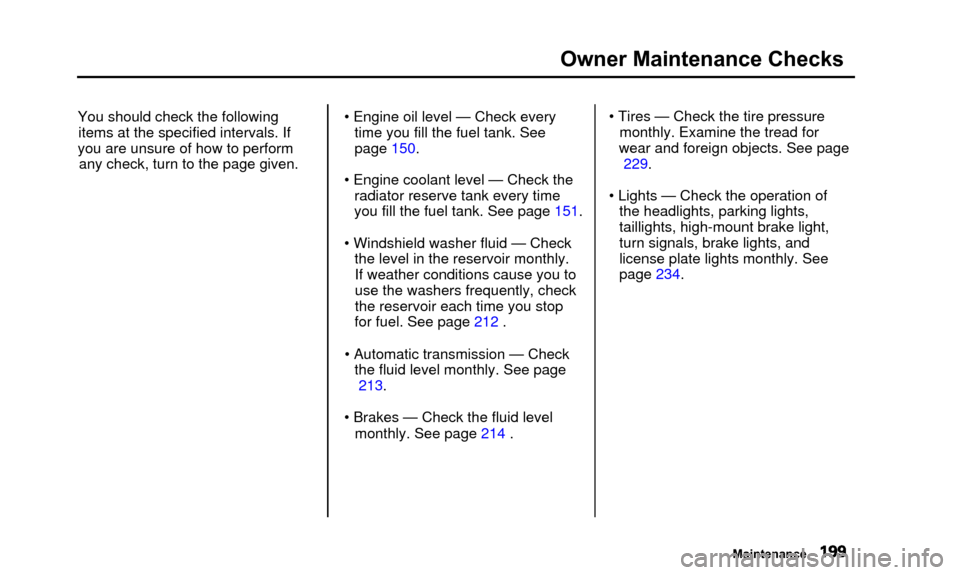
Owner Maintenance Checks
You should check the followingitems at the specified intervals. If
you are unsure of how to perform any check, turn to the page given. • Engine oil level — Check every
time you fill the fuel tank. See
page 150.
• Engine coolant level — Check the radiator reserve tank every time
you fill the fuel tank. See page 151.
• Windshield washer fluid — Check the level in the reservoir monthly.If weather conditions cause you to
use the washers frequently, check
the reservoir each time you stop
for fuel. See page 212 .
• Automatic transmission — Check the fluid level monthly. See page213.
• Brakes — Check the fluid level monthly. See page 214 . • Tires — Check the tire pressure
monthly. Examine the tread for
wear and foreign objects. See page
229.
• Lights — Check the operation of the headlights, parking lights,
taillights, high-mount brake light,
turn signals, brake lights, and
license plate lights monthly. See
page 234.
Maintenance
Page 215 of 311
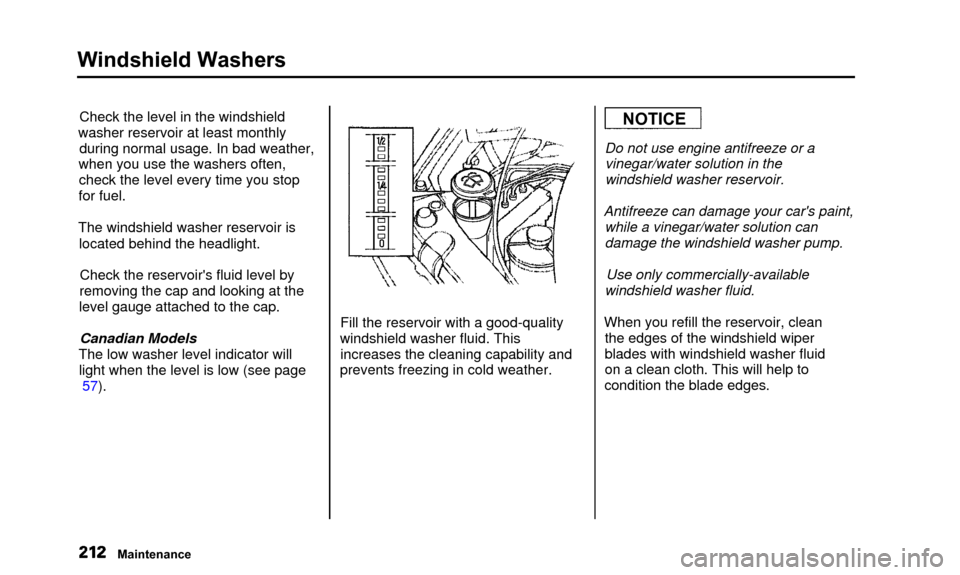
Windshield Washers
Check the level in the windshield
washer reservoir at least monthly during normal usage. In bad weather,
when you use the washers often, check the level every time you stop
for fuel.
The windshield washer reservoir is located behind the headlight.
Check the reservoir's fluid level by
removing the cap and looking at the
level gauge attached to the cap.
Canadian Models
The low washer level indicator will light when the level is low (see page 57). Fill the reservoir with a good-quality
windshield washer fluid. This increases the cleaning capability and
prevents freezing in cold weather.NOTICE
Do not use engine antifreeze or a vinegar/water solution in the
windshield washer reservoir.
Antifreeze can damage your car's paint, while a vinegar/water solution can
damage the windshield washer pump.
Use only commercially-available
windshield washer fluid.
When you refill the reservoir, clean the edges of the windshield wiper
blades with windshield washer fluid
on a clean cloth. This will help to
condition the blade edges.
Maintenance
Page 226 of 311

Wiper Blades
Check the condition of the wiper
blades at least every six months. Look for signs of cracking in the
rubber, or areas that are getting
hard. Replace the blades if you find these signs, or they leave streaks
and unwiped areas when used.WIPER ARMS
To replace the blade:
1. Turn the ignition ON (II), switch the wipers to INT or — lowposition), then turn the ignition
OFF when the wiper arm is
approximately midway in its travel.
2. Raise the wiper arm off the windshield.
LOCK TAB
3. Disconnect the blade assemblyfrom the wiper arm by pushing in
the lock tab. Hold it in while you
push the blade assembly toward
the base of the arm.
CONTINUED
Maintenance
Page 227 of 311

Wiper Blades
BLADE
4. Remove the blade from its holderby grasping the tabbed end of the
blade. Pull firmly until the tabs
come out of the holder.
BLADE
REINFORCEMENT
5. Examine the new wiper blades. If they have no plastic or metal rein-
forcement along the back edge,
remove the metal reinforcement
strips from the old wiper blade and
install them in the slots along the
edge of the new blade. 6. Slide the new wiper blade into the
holder until the tabs lock.
7. Slide the wiper blade assembly onto the wiper arm. Make sure it
locks in place.
8. Lower the wiper arm down against the windshield.
9. Turn the ignition switch ON (II) and return the windshield wipers
to their park position.
Maintenance
Page 246 of 311
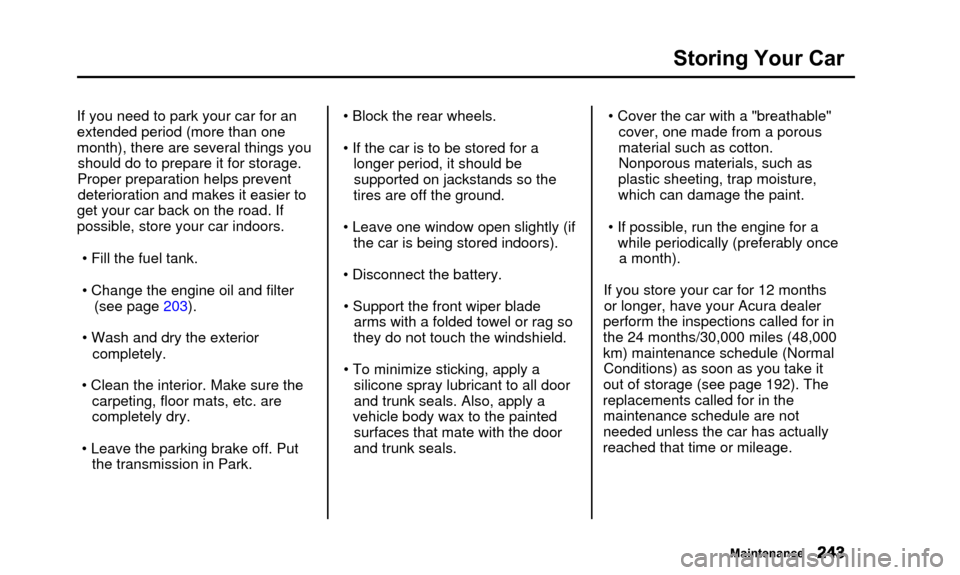
Storing Your Car
If you need to park your car for an
extended period (more than one
month), there are several things youshould do to prepare it for storage.
Proper preparation helps prevent deterioration and makes it easier to
get your car back on the road. If
possible, store your car indoors.
• Fill the fuel tank.
• Change the engine oil and filter (see page 203).
• Wash and dry the exterior completely.
• Clean the interior. Make sure the carpeting, floor mats, etc. are
completely dry.
• Leave the parking brake off. Put the transmission in Park. • Block the rear wheels.
• If the car is to be stored for a
longer period, it should besupported on jackstands so the
tires are off the ground.
• Leave one window open slightly (if the car is being stored indoors).
• Disconnect the battery. • Support the front wiper blade arms with a folded towel or rag so
they do not touch the windshield.
• To minimize sticking, apply a silicone spray lubricant to all door
and trunk seals. Also, apply a
vehicle body wax to the painted surfaces that mate with the door
and trunk seals. • Cover the car with a "breathable"
cover, one made from a porous
material such as cotton.
Nonporous materials, such as
plastic sheeting, trap moisture,
which can damage the paint.
• If possible, run the engine for a while periodically (preferably oncea month).
If you store your car for 12 months or longer, have your Acura dealer
perform the inspections called for in
the 24 months/30,000 miles (48,000
km) maintenance schedule (Normal Conditions) as soon as you take it
out of storage (see page 192). The
replacements called for in the maintenance schedule are not
needed unless the car has actually
reached that time or mileage.
Maintenance
Page 283 of 311

Identification Numbers
Your car has several identifyingnumbers located in various places.
The Vehicle Identification Number (VIN) is the 17-digit number your
Acura dealer uses to register your car for warranty purposes. It is alsonecessary for licensing and insuring
your car. The easiest place to find the VIN is on a plate fastened to the
top of the dashboard. You can see it
by looking through the windshieldon the driver's side. It is also on theCertification label attached to the
driver's doorjamb, and is stamped on
the engine compartment bulkhead.
The VIN is also provided in bar code on the Certification label.VEHICLE IDENTIFICATION NUMBER
CERTIFICATION LABEL
Technical Information
Page 285 of 311
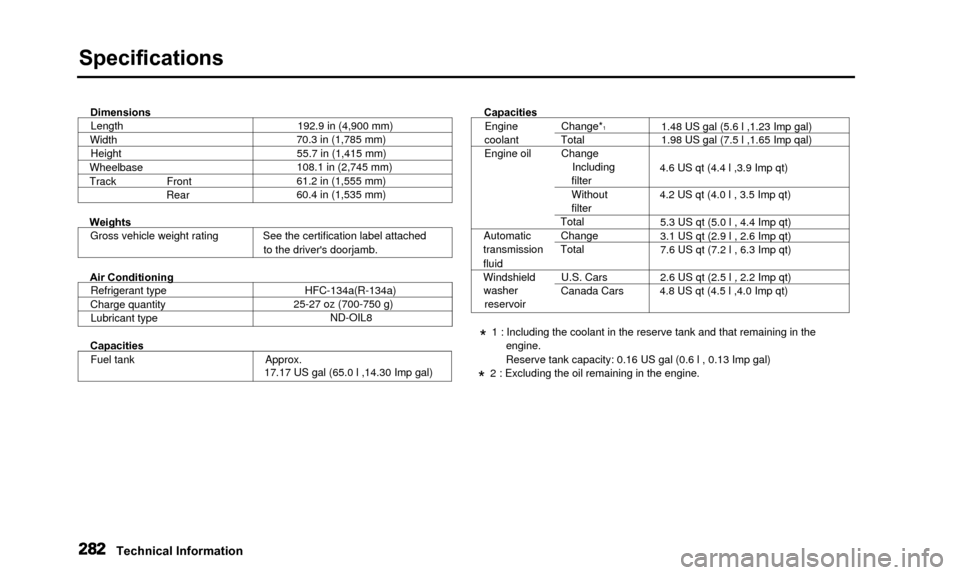
Specifications
DimensionsLength
Width Height
Wheelbase
Track Front Rear 192.9 in (4,900 mm)
70.3 in (1,785 mm)
55.7 in (1,415 mm)
108.1 in (2,745 mm)
61.2 in (1,555 mm)
60.4 in (1,535 mm) Capacities
Weights
Gross vehicle weight rating See the certification label attached to the driver's doorjamb.
Air Conditioning
Refrigerant type
Charge quantity Lubricant type HFC-134a(R-134a)
25-27 oz (700-750 g) ND-OIL8
Engine
coolant
Engine oil
Automatic
transmission
fluid
Windshield washer
reservoir Change*1Total
Change Including
filter
Without
filter
Total
Change
Total
U.S. Cars
Canada Cars 1.48 US gal (5.6 l ,1.23 Imp gal)
1.98 US gal (7.5 l ,1.65 Imp qal)
4.6 US qt (4.4 l ,3.9 Imp qt)
4.2 US qt (4.0 l , 3.5 Imp qt) 5.3 US qt (5.0 l , 4.4 Imp qt)
3.1 US qt (2.9 l , 2.6 Imp qt)
7.6 US qt (7.2 l , 6.3 Imp qt)
2.6 US qt (2.5 l , 2.2 Imp qt)
4.8 US qt (4.5 l ,4.0 Imp qt)
Capacities
Fuel tank Approx. 17.17 US gal (65.0 l ,14.30 Imp gal)
* 1 : Including the coolant in the reserve tank and that remaining in the
engine.
Reserve tank capacity: 0.16 US gal (0.6 l , 0.13 Imp gal)
* 2 : Excluding the oil remaining in the engine.
Technical Information
Page 302 of 311
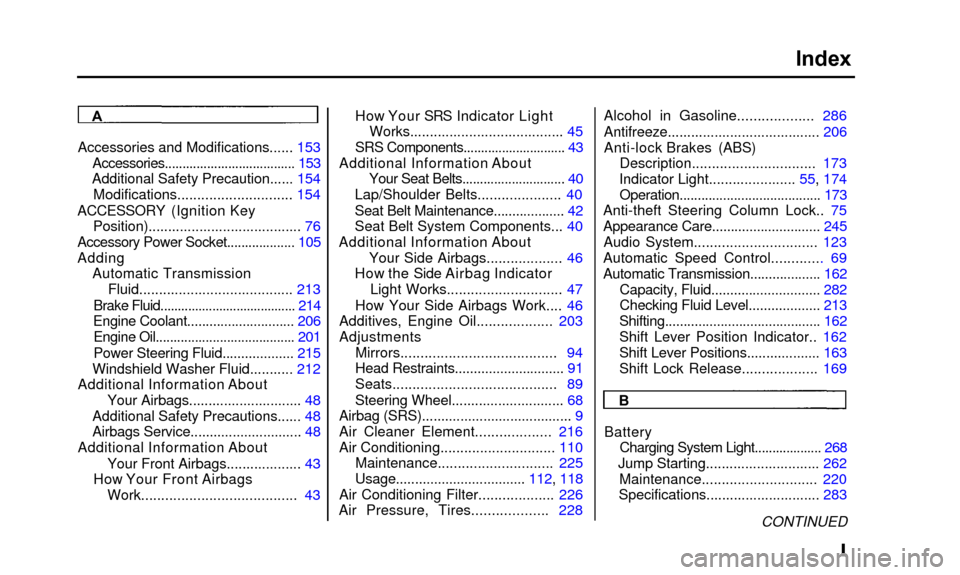
Index
Accessories and Modifications...... 153
Accessories..................................... 153
Additional Safety Precaution...... 154
Modifications............................. 154
ACCESSORY (Ignition Key Position)........ .............................. . 76
Accessory Power Socket......... .......... 105
Adding Automatic Transmission Fluid......... .............................. 213
Brake Fluid......... .............................. 214
Engine Coolant......... .................... 206
Engine Oil....................................... 201
Power Steering Fluid................... 215
Windshield Washer Fluid......... .. 212
Additional Information About Your Airbags........ ..................... 48
Additional Safety Precautions...... 48
Airbags Service........ ..................... 48
Additional Information About
Your Front Airbags................... 43
How Your Front Airbags Work........ .............................. . 43How Your SRS Indicator Light
Works....................................... 45
SRS Components............................. 43
Additional Information About Your Seat Belts........ ..................... 40
Lap/Shoulder Belts..................... 40
Seat Belt Maintenance................... 42
Seat Belt System Components... 40
Additional Information About Your Side Airbags................... 46
How the Side Airbag Indicator Light Works............................. 47
How Your Side Airbags Work.... 46
Additives, Engine Oil................... 203
Adjustments Mirrors....................................... 94
Head Restraints........ ..................... 91
Seats........................................ . 89
Steering Wheel............................ . 68
Airbag (SRS)....................................... 9
Air Cleaner Element................... 216
Air Conditioning............................. 110
Maintenance......... .................... 225
Usage................................. . 112, 118
Air Conditioning Filter......... .......... 226
Air Pressure, Tires......... .......... 228Alcohol in Gasoline................... 286
Antifreeze.........
.............................. 206
Anti-lock Brakes (ABS) Description......... ...................... 173
Indicator Light......... ............. 55, 174
Operation....................................... 173
Anti-theft Steering Column Lock.. 75
Appearance Care............................. 245 Audio System............................... 123
Automatic Speed Control........ ..... 69
Automatic Transmission......... .......... 162
Capacity, Fluid............................. 282
Checking Fluid Level................... 213
Shifting.......................................... 162
Shift Lever Position Indicator.. 162
Shift Lever Positions................... 163
Shift Lock Release......... .......... 169
A
B
Battery Charging System Light................... 268
Jump Starting......... .................... 262
Maintenance............................. 220
Specifications......... .................... 283
CONTINUED
Page 305 of 311
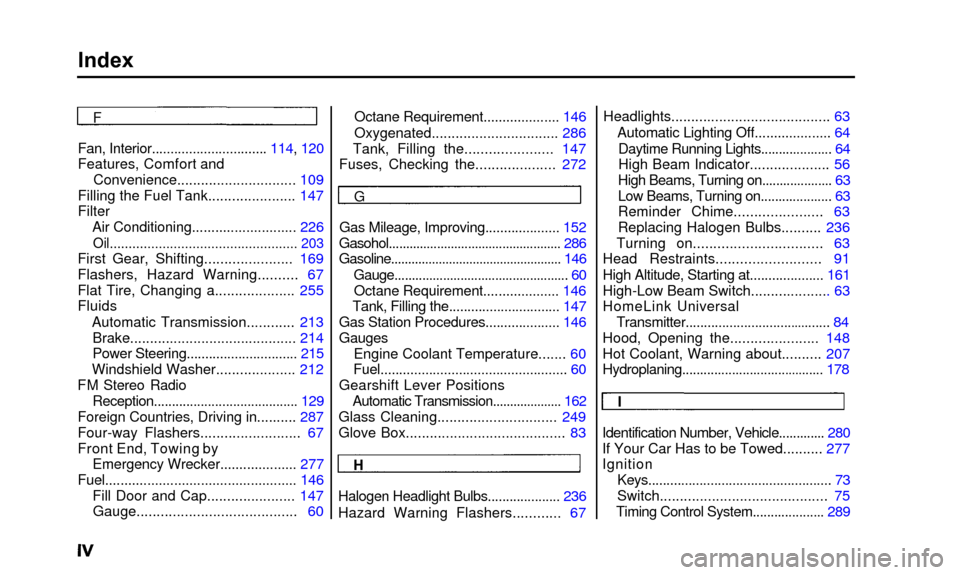
Index
Fan, Interior............................... 114, 120
Features, Comfort andConvenience.............................. 109
Filling the Fuel Tank...................... 147
Filter Air Conditioning.......... ................. 226
Oil.................................................. 203
First Gear, Shifting.......... ............ 169
Flashers, Hazard Warning.......... 67
Flat Tire, Changing a.................... 255
Fluids
Automatic Transmission.. .......... 213
Brake.......... ................................ 214
Power Steering.............................. 215
Windshield Washer.................... 212
FM Stereo Radio Reception........................................ 129
Foreign Countries, Driving in.......... 287
Four-way Flashers......................... 67
Front End, Towing by
Emergency Wrecker.................... 277
Fuel.................................................. 146
Fill Door and Cap...................... 147 Gauge........................................ 60 Octane Requirement..........
.......... 146
Oxygenated.......... ...................... 286
Tank, Filling the.......... ............ 147
Fuses, Checking the.......... .......... 272Headlights.......................................
. 63
Automatic Lighting Off.................... 64 Daytime Running Lights......... ........... 64
High Beam Indicator.................... 56
High Beams, Turning on......... ........... 63
Low Beams, Turning on......... ........... 63
Reminder Chime...................... 63
Replacing Halogen Bulbs.......... 236
Turning on......... ....................... 63
Head Restraints.......................... 91
High Altitude, Starting at.......... .......... 161
High-Low Beam Switch......... ........... 63
HomeLink Universal Transmitter.............................
.......... . 84
Hood, Opening the...................... 148
Hot Coolant, Warning about.......... 207
Hydroplaning.............................
........... 178
F
G
Gas Mileage, Improving.......... .......... 152
Gasohol.................................................. 286
Gasoline.................................................. 146
Gauge......... ........................................ . 60
Octane Requirement.......... .......... 146
Tank, Filling the.......... .................... 147
Gas Station Procedures.................... 146
Gauges
Engine Coolant Temperature... .... 60
Fuel................................................. . 60
Gearshift Lever Positions Automatic Transmission.................... 162
Glass Cleaning.............................. 249
Glove Box....................................... . 83
H
Halogen Headlight Bulbs.................... 236
Hazard Warning Flashers.......... .. 67I
Identification Number, Vehicle............. 280
If Your Car Has to be Towed.......... 277
Ignition
Keys................................................. . 73
Switch......................................... . 75
Timing Control System.......... .......... 289